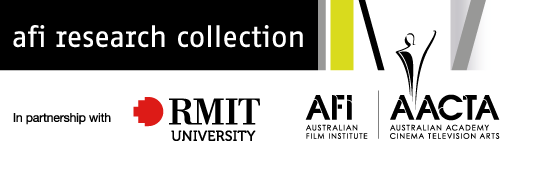journal article
The Entertainer and Room At the Top in Montage (1962) vol.1 iss.1 p.5-7
More info
book
Film makers on film making : Statements on their art by thirty directors / Geduld, Harry M. (editor) Harmondsworth: Penguin, 1967.
Call No: 802.25 FILPlace: HarmondsworthPublisher: PenguinPubDate: 1967PhysDes: 18 cm; 303 p.Subject: AUTHORSHIP ; LUMIERE, LOUIS ; PORTER, EDWIN S. ; SENNETT, MACK ; GRIFFITH, DAVID WARK ; FLAHERTY, ROBERT ; CHAPLIN, CHARLES ; VON STROHEIM, ERICH ; VERTOV, DZIGA ; DREYER, CARL TH. ; HITCHCOCK, ALFRED ; RICHARDSON, TONY ; COCTEAU, JEAN ; RESNAIS, ALAIN ; ROBBE-GRILLET, ALAIN ; BUNUEL, LUIS ; BERGMAN, INGMAR ; FELLINI, FEDERICO ; VON STERNBERG, JOSEF ; ANTONIONI, MICHELANGELO ; LANG, FRITZ ; WAJDA, ANDRZEJ ; WELLES, ORSON ; RAY, SARYAJIT ; KUROSAWA AKIRA ; ANDERSON, LINDSAY ; LEAN, DAVID ; RENOIR, JEAN ; BARDEM, JUAN ANTONIO ; ANGER, KENNETH Summary: Does the making of films – a group activity – permit anything that can be called self-expression? Can a director, as the conductor of an orchestra of writers, actors, cameramen and technicians, stamp his personal vision on the films he makes? This and related questions are raised by this collection of statements made by famous directors about their art. Harry Geguld’s anthology of “patristic writings” runs from the days (in 1895) when Louis Lumiere filmed a train entering a station, by way of Charlie Chaplin’s knockabout ad-libbing, to the sophisticated ruminations of Antonioni and Bergman and the ideas behind the nouvelle vague. Here is D.W. Griffith’s scouting the very idea of talking pictures; Mack Sennett on custard pies; Eisenstein on three-dimensional film; Cocteau on the raw materials of illusion; Kurosawa on filming in Japan; Hitchcock on the macabre; and some other twenty leading directors on aspects of their work. In his introduction, Harry Geguld assesses the unique characteristics of motion pictures and comments refreshingly on the eternal controversy of “book into film”. [Taken from back cover.]ID2: 291
More info
journal article
Lensing starts on 'The Hotel New Hampshire' in Australasian Cinema (10/6/1983) vol.12 iss.10 p.2
More info
journal article
Profile: Director Lindsay Anderson in Australasian Cinema (16/07/1982) vol.11 iss.12 p.28
PhysDes: ArticleSubject: ANDERSON, LINDSAY ; CRITICISM ; THEORY ; LOOK BACK IN ANGER (UK, Tony Richardson, 1959) ; RICHARDSON, TONY ; REISZ, KAREL ; INDUSTRY, FILM. UK ; O LUCKY MAN! (UK, Lindsay Anderson, 1973) ; BRITANNIA HOSPITAL (UK, Lindsay Anderson, 1982) Summary: Article on Lindsay Anderson, covering his writings for Sequence, his work with Richardson and Reisz in the 'British New Wave', his short documentaries, and his feature films.
More info
Richardson Does Fielding...Tom Jones in University Film Group Bulletin (1964) iss.6 p.2-4
More info
personality microfilm collection
RICHARDSON, TONY
Call No: PERSONALITY MICROFILM COLLECTIONPhysDes: ClippingsSubject: RICHARDSON, TONY
More info
Yet to catalogue
book
Studies in documentary / [by] Alan Lovell and Jim Hillier London: Secker and Warburg [for] the British Film Institute, 1972.
Call No: 761(41) LOVAuthor: Lovell, Alan ; Hillier, Jim, joint author Source: UKPlace: LondonPublisher: Secker and Warburg [for] the British Film InstitutePubDate: 1972PhysDes: 176 p. illus., ports. 20 cmSubject: DOCUMENTARIES ; DOCUMENTARY FILMS. UK ; FREE CINEMA ; HISTORY OF CINEMA. 1930's ; HISTORY OF CINEMA. 1940's ; HISTORY OF CINEMA. 1950's ; GRIERSON, JOHN ; JENNINGS, HUMPHREY ; ANDERSON, LINDSAY ; REISZ, KAREL ; RICHARDSON, TONY ; FIRES WERE STARTED [I WAS A FIREMAN] (UK, Humphrey Jennings, 1943) Summary: "If the British cinema has a central tradition, a case can be made for it to be the documentary tradition. In this volume, Alan Lovell and Jim Hillier study the three main epochs of this tradition. Alan Lovell writes about the aims and theories of the seminal producer of documentaries in the 1930s, Hohn Grierson, showing how the theory became practice and with what results. His detailed and lucid account, supplemented by a full filmography, is likely to prove invaluable to students of the period. Jim Hillier takes the narative into the '40s and writes about the work of Humphrey Jennings, whose poetic imagination and gift for character transformed the reality of wartime England into contemplative statements: Fires Were Started remains one of the few genuine works of art to come from the cinema during the war. Finally, Alan Lovell describes the origins of the Free Cinema movement of the '50s, attempting to separate the individual talents (Tony Richardson, Karel Reisz, Lindsay Anderson) from the shared aesthetic and political assumptions of the time, and asks the question: How far was Free Cinema a genuine cause and how far was it a means of self-promotion for a limited group? This is not a book written to win friends among the film-making establishment, and its forthright view from the 1970s is likely to arouse passion in interested quarters." -- BOOK BLURBNotes: Bibliography: p. 173-175ISBN: 0436099187; 0436099195 (pbk.)LON: 548482 548482
More info

